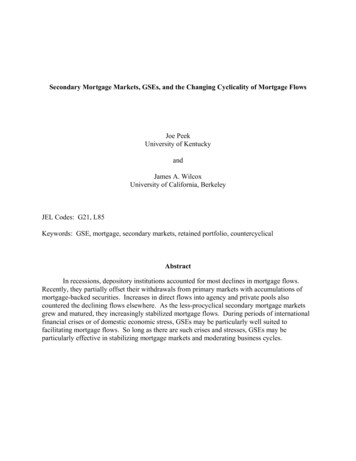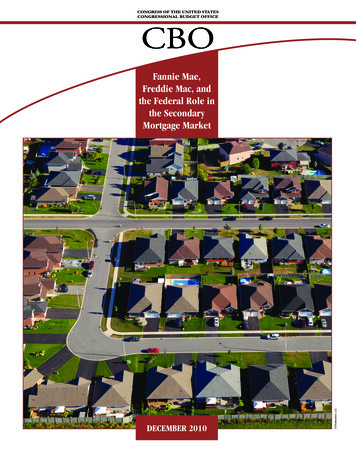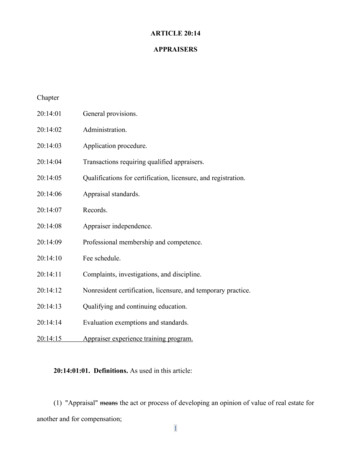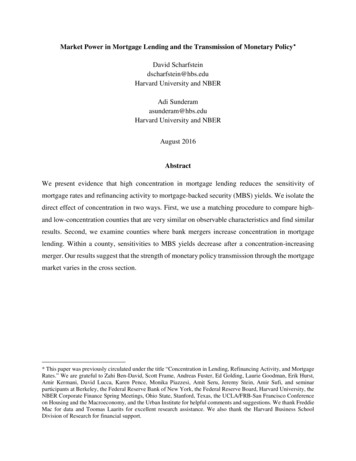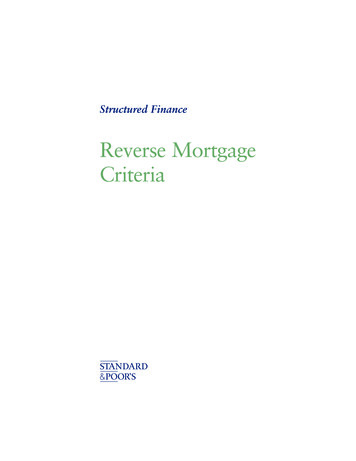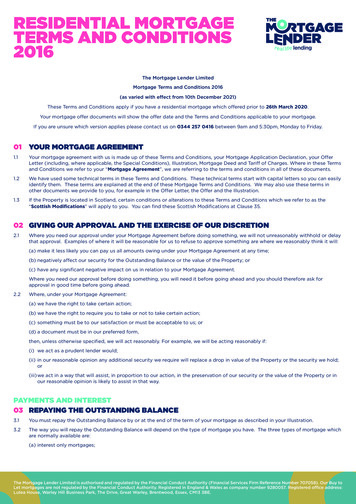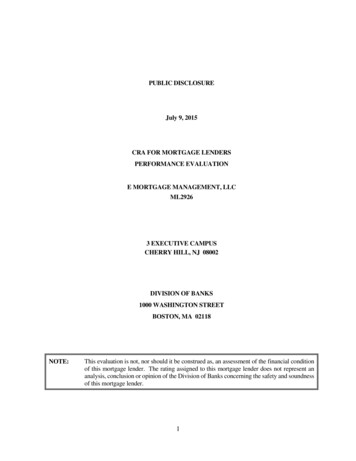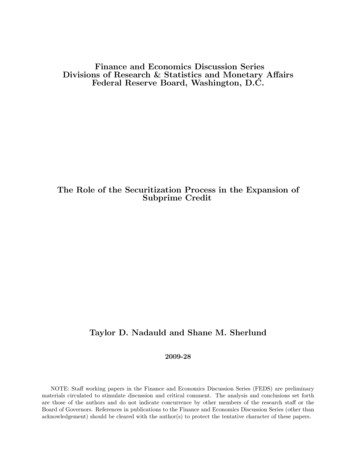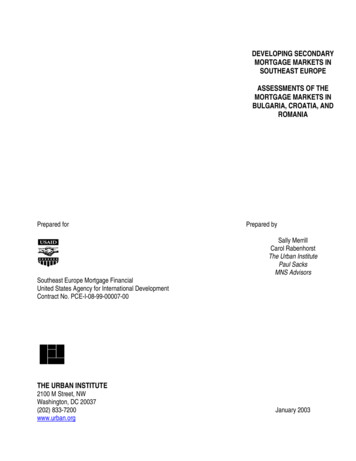
Transcription
K:\IAC\THogan\EMAIL INCOMING\NEW REPORTS TO WORK ON\PRIORITY\AssessmentReportsFinal.docDEVELOPING SECONDARYMORTGAGE MARKETS INSOUTHEAST EUROPEASSESSMENTS OF THEMORTGAGE MARKETS INBULGARIA, CROATIA, ANDROMANIAPrepared forSoutheast Europe Mortgage FinancialUnited States Agency for International DevelopmentContract No. PCE-I-08-99-00007-00Prepared bySally MerrillCarol RabenhorstThe Urban InstitutePaul SacksMNS AdvisorsTHE URBAN INSTITUTE2100 M Street, NWWashington, DC 20037(202) 833-7200www.urban.orgJanuary 2003
ACKNOWLEDGEMENTSThe Urban Institute carried out these Assessments of theMortgage Markets in Bulgaria, Croatia, and Romania, which weresupported by USAID’s Office for Economic Growth, Bureau for Europeand Eurasia, in the fall of 2002. The authors were Sally Merrill and CarolRabenhorst of the Urban Institute and Paul Sacks, president of MultiNational Systems Advisors, a consultant to the Urban Institute.The Assessments were prepared as background information forthe USAID-supported conference “Developing Secondary MortgageMarkets in Southeast Europe” to be held in Sofia on February 4 and 5,2003.We wish to gratefully acknowledge the support of a number ofpersons who have provided invaluable assistance in developing theConference and supporting the research. First, we thank Jean Lange,the technical manager for this project at USAID, for her excellentassistance and insights. We also wish to thank our colleagues inSoutheast Europe: Krassen Stanchev, President, and Asenka Hristova,Research Director, of the Institute for Market Economics, Sofia; DorelSandor, President of the Center for Political Studies and ComparativeAnalysis, Romania, and Ion Bejan, National Housing Agency, Romania;and Ken Kopstein and Jeremy Gustafson, the Urban Institute and SonjaFreiberger of Mercy Corp in Croatia. All were invaluable local partners inoffering their expertise, providing information, and arranging for thenumerous interviews conducted for the Assessments.The Institute for Market Economics is also the Urban Institute’spartner in arranging the Conference and we offer their staff, especiallySvetla Kostadinova and Pavlina Petrova, our very warm appreciation.
TABLE OF CONTENTSASSESSMENT OF THE BULGARIAN MORTGAGE MARKET. 1EXECUTIVE SUMMARY. 11.0 OVERVIEW OF THE PRIMARY MORTGAGE MARKET . 21.1 Overview of Banking System and Economic Environment. 21.2 Overview of Consumer and Mortgage Lending in Bulgaria . 3Table 1 Private Sector and DSK Housing Loans Outstanding . 31.3 Mortgage Loan Products . 41.4 Underwriting Criteria and Credit Risk . 51.5 Other Mortgage Market Issues . 52.0LEGAL ISSUES IN THE MORTGAGE MARKET . 62.1 Foreclosure. 62.2 Mortgage Bond Law . 72.3 Basic Enabling Laws . 72.4 Fees and Expenses. 83.03.13.23.33.43.5SECONDARY MORTGAGE MARKET AND FUNDING ISSUES. 9Bank Funding Strategies . 9Capital Market Profile . 9Potential Investors: Pension Funds and Insurance Companies . 10Central Bank Regulatory Policy. 10European and Regional Issues in Funding and Standardization. 11ASSESSMENT OF THE CROATIAN MORTGAGE MARKET . 12EXECUTIVE SUMMARY. 121.0 OVERVIEW OF THE PRIMARY MORTGAGE MARKET . 121.1 Overview of the Banking Sector and Economic Environment . 121.2 Overview of Consumer and Mortgage Lending . 13Table 1 Consumer and Housing Lending . 141.3 Mortgage Loan Products . 141.4 Underwriting Criteria and Credit Risk . 151.5 Other Aspects of the Primary Mortgage Market . 162.03.02.12.22.3THE LEGAL INFRASTRUCTURE OF MORTGAGE LENDING. 17Foreclosure. 17Fiduciary Mortgage. 18Basic Enabling Laws . 183.13.23.33.43.53.6SECONDARY MORTGAGE MARKET AND FUNDING ISSUES. 20Bank Funding Strategies . 20Capital Market Profile . 20Bank Risk Management . 21Potential Investors—Pension Funds and Insurance Companies. 21National Bank and other Regulatory Policy Impacting Investor Rules. 22European and Regional Issues in Funding and Standardization. 23
TABLE OF CONTENTS (CONTINUED)ASSESSMENT OF THE ROMANIAN MORTGAGE MARKET . 23EXECUTIVE SUMMARY. 231.0 OVERVIEW OF THE PRIMARY MORTGAGE MARKET . 231.1 Overview of the Banking Sector and Economic Environment . 231.2 Overview of Consumer and Mortgage Lending . 241.3 Mortgage Loan Products . 251.4 Underwriting Criteria and Credit Risk . 261.5 Other Aspects of the Primary Mortgage Market . 262.02.12.2THE LEGAL INFRASTRUCTURE OF MORTGAGE LENDING. 27Foreclosure. 27Basic Enabling Laws . 273.13.23.33.43.53.6SECONDARY MORTGAGE MARKET AND FUNDING ISSUES. 29Bank Funding Strategies . 29Legal Infrastructure for Secondary Mortgage Market . 30Capital Market Profile . 30Potential Investors: Pension Funds and Insurance Companies . 31National Bank and other Regulatory Policies Impacting Investor Rules. 31European and Regional Issues in Funding and Standardization. 323.0
ASSESSMENT OF THE BULGARIAN MORTGAGE MARKETEXECUTIVE SUMMARYBulgaria has now emerged from the severe economic and banking crisis of the mid-1990s, andstands poised to reap the benefits of resumption in economic growth and a continued fall in inflation.Bulgaria has nearly completed the privatization and rationalization of its banking sector and continues toput in place a legal infrastructure that will be highly supportive of mortgage lending. Demand is stillrelatively weak, and thus the mortgage portfolio is very small, about 100 million, but it should continue togrow if positive trends in income growth and monetary stability continue.Although funding of mortgage loans is still largely achieved through deposits, Bulgaria has passeda mortgage bond law, which is the first in the region. The law is flexible, especially in that it does notrequire establishment of separate mortgage banks. Five banks have already issued mortgage bonds, whichhave been quickly purchased by the pension funds. These banks are Bulgarian American Credit Bank(BABC, two issuances), Express Bank, Post Bank, Economic and Investment Bank, and First InvestmentBank. United Bulgarian Bank (UBB) is also planning to issue a mortgage bond.Pension reform is largely completed and the demand by the pension funds for alternatives toinvesting in Government securities, in combination with a capital market profile favorable to development ofthe mortgage bond market, will help assure the success of this risk management strategy in the future. Inaddition, Bulgaria is now working on further institutional and legal initiatives—a credit bureau and lawsupporting development of SPVs (Special Purpose Vehicles), which will assist in the creation of MBS(mortgage-backed securities).A livelier mortgage market should emerge as the past dominance in mortgage lending of the StateSavings Bank (DSK) decreases and a more competitive lending environment continues to grow, togetherwith continued recovery in the economic environment.Some barriers to mortgage market development remain. While Bulgaria has generally adopted anadequate legal framework to support the mortgage market, there has been little legal reform of the loanrecovery process, a factor that increases risk in the primary market. Foreclosure procedures under the CivilProcedure Code and the Execution Law require a court procedure and are described as “fiercely prodebtor.” Inadequate judicial resources further delay the process, especially in Sofia and other large cities.Also, interest rate spreads may remain high, reflecting foreclosure and other risks facing the banks as wellas inefficiencies in bank operations and information systems. In summary, however, Bulgaria has mademajor strides in overcoming its structural and economic crises and adopting an overall systemic reform thatwill provide important support to efficient and effective consumer and mortgage lending in the future.
Southeast EuropeMortgage Financial21.0OVERVIEW OF THE PRIMARY MORTGAGE MARKET1.1Overview of Banking System and Economic EnvironmentBulgaria has achieved considerable success in its efforts to provide a stable and dynamic macroeconomic and monetary environment, having now emerged from the major economic crisis suffered in themid-1990s. Real GDP per capita had plummeted and inflation had reached 578.6 percent by 1997. Therecovery is well underway, however. According to the Bulgarian National Bank (BNB), real GDP reachedpre-crisis levels in 2002. Inflation has been largely tamed, standing at about 9.0 percent in 2002 andexpected to fall to 5.5 percent in 2003. Under Bulgaria’s Currency Board, the Bulgarian level (BGN) is fixedto the Euro.The economic crisis also engulfed the banking system, and in 1996 and 1997, the sectorexperienced a severe collapse. Eighteen banks were closed, amounting to about one-third of the bankingsector. Poor behavioral practices by the banks, including inadequate internal controls, insider lending, andinadequate risk management, led to large numbers of bad loans.1 There were institutional weaknessesincluding inadequate capitalization, and poorly developed regulation and supervision, including insufficientenforcement of prudential standards.The banking system is now on its way to recovery. Although privatization occurred more slowlythan planned, the sector is finally nearly fully privatized, with much of the controlling interest in Bulgaria’scommercial banks sold to strategic investors. The new owners include major Italian, Greek, French andAmerican institutions, and about 80 percent of the banking system is now foreign-owned. The principalexception is the State Savings Bank (DSK), privatization of which has experienced major delays andbarriers. DSK is now scheduled to be privatized in June 2003.While privatization is relatively recent, its effects are becoming increasingly noticeable. Newbanking products—car loans, credit cards, leases, mortgages, etc., —are now available. Moreover, bankshave begun to move away from portfolio strategies geared to harvesting the gap between cheap depositsand yields on government bonds. Loans are now a growing, but are not yet the dominant element on bankbalance sheets. According to one recent report“ the stock of credits to non-financial entities picked up by34.2 percent in 2002” (Bulgaria Today, Intellinews, 1-02-03).Recent reforms are gradually improving confidence in the banking sector, and banking assets areslowly increasing again as a share of GDP. Improved prudential regulations, stricter supervisory policies,higher solvency requirements, and bank consolidation and foreign investment are among the positivefactors. However, some observers have concluded that Bulgarian banks are currently too risk averse. Thecapital adequacy ratio is quite high at 20 percent as compared with the required level of 12 percent. Andalthough the banks are liquid, they are generally not adopting an aggressive lending posture.1 See “Banking Sector: Bulgaria”, Assenka Yonkova, Institute for Market Economics, 2000
1.2Overview of Consumer and Mortgage Lending in BulgariaBased on a study carried out by the Institute for Market Economics (IME) in June 2002, the 10largest banks doing consumer lending are listed below. Their share of overall consumer lending, whichincludes mortgage lending, is noted; banks active in the emerging mortgage market are marked with anasterisk. State Savings Bank* (DSK): 69%SGExpress Bank*: 8%UBB* (NBG Group): 6%Post Bank* (AIG): 6 %Bulbank* (UniCredito): 2%Bulgarian American Credit Bank*: 2%Biochim (Bank Austria): 2%First Investment Bank*: 1%ProCredit Bank (EBRD Initiative): 1%Historically, all mortgage lending was undertaken by DSK. While DSK is still very predominant, it islosing share to over a half dozen competitors. The overall mortgage portfolio was roughly 100 million inthe fall of 2002, of which over one-half is held by the DSK (refer to Table 1). Other banks lending forhousing include UBB, Post, Bulbank, BACB, First Investment Bank, Express Bank, and Raiffeisen. Data onmortgage loans made by these banks, which is collected by the Bulgarian National Bank (BNB), is alsoshown in Table 1.Mortgage lending effectively resumed in 1999 and has grown at an accelerating pace ever since.After a healthy increase of 27.4 percent during 2001, the banks’ portfolios grew by 54.3 percent throughNovember 2002. In a relative sense—as a proportion of GDP for example—the total mortgage portfolio isstill extremely small, however.Table 1Private Sector and DSK Housing Loans OutstandingMortgage Loans by YearDecember 2001November 2002BGN 97,641BGN 131,360BGN 179,9261.9472.1022.2191.970Mortgage Loans ( 000s) 41,500 46,451 59,198 91,332Percent ChangeN/A11.9%27.4%54.3%Mortgage Loans (BGN: 000s)Exchange Rate (BGN for 1.0)December 1999December 2000BGN 80,802Source: National Bank of Bulgarian and the Institute for Market EconomicsFunding of mortgage loans is based largely on deposits, which tend to be very short-term. Asfurther discussed in Section 3.0, although mortgage bonds are being issued, they have been of verymodest size. One interesting aspect of the mortgage bond issuances is that they are not yet competitive
Southeast EuropeMortgage Financial4with funding from deposits. The cost of funds, although varying from bank to bank, is reportedly quite low(around 3 percent) and bond funding is less cost effective. On the other hand, the deposits are very shortterm, and the bond issuances may be viewed as test cases for improved risk management strategies vialonger-term funding in the future. (As noted below, however, the mortgage bonds themselves have beenrelatively short-term – 3 years.) Banks are quite liquid and interest rates remain relatively high, in part afunction of tight fiscal policy. This, in essence, crowds out private debt. Also, as noted, banks remainsomewhat risk averse, and spreads are still felt to be high. Future issuances will, of course, depend onbank liquidity, the need for long-term resources, and the strength in demand brought about by improvedaffordability.Nevertheless, all trends are moving in a positive direction. With the entry of new banks intomortgage lending, the past dominance of the DSK is diminishing and the mortgage lending system isincreasingly competitive. This should be beneficial to both the rate structure and loan product developmentin the future.1.3Mortgage Loan ProductsBanks provide mortgage loans for new housing, existing housing, and rehabilitation. Mortgageloans are primarily denominated in BGN. Terms, which were previously 5 to 10 years, have recently beenextended to up to 20 years. The loans are variable rate, with rates updated at the bank’s convenience.LTVs (loan-to-value ratio) generally range from 70 to 80 percent (although see the discussion in Section 1.4below: effective LTVs may be lower).Mortgage interest rates for loans in BGN have fallen from 17 to 18 percent in 2000 to 12 to 14percent by the third quarter of 2002. (As a point of comparison, ten-year Government bonds yielded about8.0 to 8.5 percent at that time.)As a specific example, DSK’s interest rate on its variable rate BGN loans stood at 13.75 percent inthe fall of 2002, down from 16 percent in April 2002. Spreads are quite high, as DSK notes that its averagecost of funds is 1 percent for demand deposits and 3 to 4 percent for time deposits. The maximum loanterm is 15 years and maximum LTV is 80 percent, although loans are more typically at an LTV of 70percent. Interestingly, loan terms vary according to construction type and building materials, the rationalebeing that these factors have a major impact on the expected life of the building. Thus, for example, loanterms for panel construction are less liberal than for brick.Raiffeisen, in contrast, bases its loan terms on a classification scheme for clients, using incomelevel, quality of collateral and credit history among other factors. The bank has targeted upscale borrowers.Interest rates (as of fall 2002) varied from 8.8 to 12.95 percent, and terms from 3 to 7 years; LTV was amaximum of 70 percent.Post Bank’s interest rates depend on the loan term and the currency. Loans in BGN, for example,were at 12.75 percent for 10 years, 13.75 percent for 15 years, and 14.75 percent for a 20-year loan;interest rates for comparable loans in Euro were somewhat lower.
1.4Underwriting Criteria and Credit RiskOverall, mortgage loans are performing fairly well and overdue loans represent only 0.3 percent.There is a rather large range, from 1 to 5 percent, across lenders in reported estimates of the number ofloans in default (that is, over 90 days overdue). There is little experience with the foreclosure process,however. As discussed in Section 2.1, foreclosure is not a commonly used remedy: it is time consumingand expensive and the outcome is uncertain.Banks are generally quite conservative in underwriting mortgage loans, sometimes requiring othersecurity such as accounts maintained by the borrower in the bank. In addition, the LTV ratios may be lowerthan they appear, as banks routinely decrease the appraised value of the property before considering loansize. As discussed below, the appraised value is discounted about 20 percent before the LTV isdetermined, to compensate for the uncertainty of the lender’s ability to recover collateral in event of default.Third-party guarantees were once typically required, but in recent years the use of this security hasdeclined.1.5Other Mortgage Market IssuesCredit Bureau—Bulgaria is now working on an institutional initiative that is of key importance to aneffective mortgage market—a credit bureau. A thorough analysis has been made of the issues surroundingcredit bureau development and a team has visited credit bureaus in other countries, including Turkey andPoland.2 A feasibility study has been prepared recommending a private credit bureau that would serve notonly banks but also utility companies and leasing companies. It is also hoped that the SME sector would beincluded. One key problem concerns reporting of “positive” customer credit information; a legal constraintstems from bank secrecy requirements, and thus collection of positive credit information would require achange in the Banking Act and Personal Data Collection Act. A number of the major Bulgarian banks havestated their willingness to become shareholders, and the remaining banks would be expected to pay a feefor services. However, given the dominance of DSK in consumer and mortgage lending, its participation iscrucial, and the bank is waiting until after its privatization to commit to the credit bureau.Currently, the National Bank of Bulgaria maintains a central credit registry; however, this coversonly loans over EU 5,000, and it is felt that banks do not fully comply with reporting requirements.Appraisal—The Mortgage Bond Law provides a number of options for appraisal methodologies formortgages underlying bonds–comparable sales, revenue generation, and material value (replacementcost). Independent appraisers are active and are certified by the Privatization Agency. Some banks,however, have not been fully satisfied with the available valuers nor with the valuation methodologies asapplied to residential real estate lending. Thus, many banks have their own appraisers, although theysometimes rely on the independent appraisers, who are often affiliated with real estate agencies. The bankselects the valuer and pays for the appraisal.The overall valuation process as applied to the underwriting function remains flawed, however,especially in determining value based on the “market comparables” methodology. First, banks still do notappear to trust the appraisal process, because appraised values are slashed by as much as 20 percent2 The Institute or Market Economics and the Bulgarian American Credit Bank have both been very active in the research process andpolicy dialogue supporting formation of a credit bureau.
Southeast EuropeMortgage Financial6when determining the mortgage loan amounts. (BACB notes that it used to slash the independentappraisals, but has now developed an improved in-house valuation capacity.) Second, properties areregistered at less than appraised value; this makes utilization of the comparables approach very difficult.Taxes—Because of the two percent transfer tax, many sales are reported at lower than actualvalue. This makes it difficult to conduct appraisals strictly by the comparable-sales method. As the markethas matured, this factor is usually taken into account. Because of loan recovery difficulties, however,mortgages are still given on substantially less than real market value, as noted.Real Estate Industry—The real estate industry is well established in Bulgaria, particularly in Sofiaand other major cities, and the resort areas on the coast. There is a National Real Property Association thatissues standards for the industry, but they are not mandatory. Many realtors also provide appraisalservices. In the last year, there were approximately 100,000 sales of real estate in Bulgaria. Estimates ofsales with mortgages range from 2,500 to 15,000. Realtors generally charge a commission of 5 percent ofthe sales price, which is usually split by the buyer and the seller.Realtors typically have sophisticated databases of properties and sales prices, and web sites listingproperties on the market. While there is no formal multiple listing services, five of the largest realtors inSofia, all of which handle sales and appraisals, share information on a voluntary basis. This program iscalled “Info-Pool.” The primary form of advertising is though the newspaper, not via web sites.2.0LEGAL ISSUES IN THE MORTGAGE MARKET2.1ForeclosureThe most serious constraint to the expansion of mortgages lending, and to further development ofmortgage bonds and/or MBS is the difficult and lengthy foreclosure system. There have been only a fewforeclosures, but the banks have had enough experience to testify that the system is difficult and very timeconsuming. Implementation is the major drawback: there are too few judges and they are said to be notsufficiently knowledgeable about the process. The debtor can appeal the process at many stages, and asa result, foreclosure takes one to two years. Foreclosure is said to work better in smaller locales than in thelarge urban areas, due to a severe shortage of judges in the latter.A court judgment is required, and the “executive judge” (judge with authority to oversee executionprocedures) supervises each step, including appraisal of the property, public sale or auction, and eviction.The debtor has many opportunities to challenge the procedure or appeal the decisions of the court.Costs include court and legal fees, the costs of auctioning the property, and the diminution in valueof the property as a result of delays and uncertainty in the foreclosure and eviction process.Auction process—Auction procedures must be supervised by the court; no private sales arepermitted through the foreclosure process. The time periods provided in the law are similar to those ofother countries, with the minimum time to foreclosure about 6 months, but because of the debtor’s right to
challenge the procedures, completion of a foreclosure can be expected to take much longer than theminimum time.2.2Mortgage Bond LawAs noted, Bulgaria adopted a Mortgage Bond Law in 2000.3 Several banks have issued bondsunder the new law, and more issuances are planned. The law does not establish specialized mortgagebanks or provide government guarantees or subsidies, so the primary mortgage market has been allowedto develop according to market-driven factors. Any banks licensed by the Bulgarian National Bank canissue bonds collateralized by the bank’s mortgage debt or other assets in accordance with regulations setby BNB. The collateral value is discounted fr
A livelier mortgage market should emerge as the past dominance in mortgage lending of the State Savings Bank (DSK) decreases and a more competitive lending environment continues to grow, together with continued recovery in the economic environment. Some barriers to mortgage market development remain. While Bulgaria has generally adopted an
